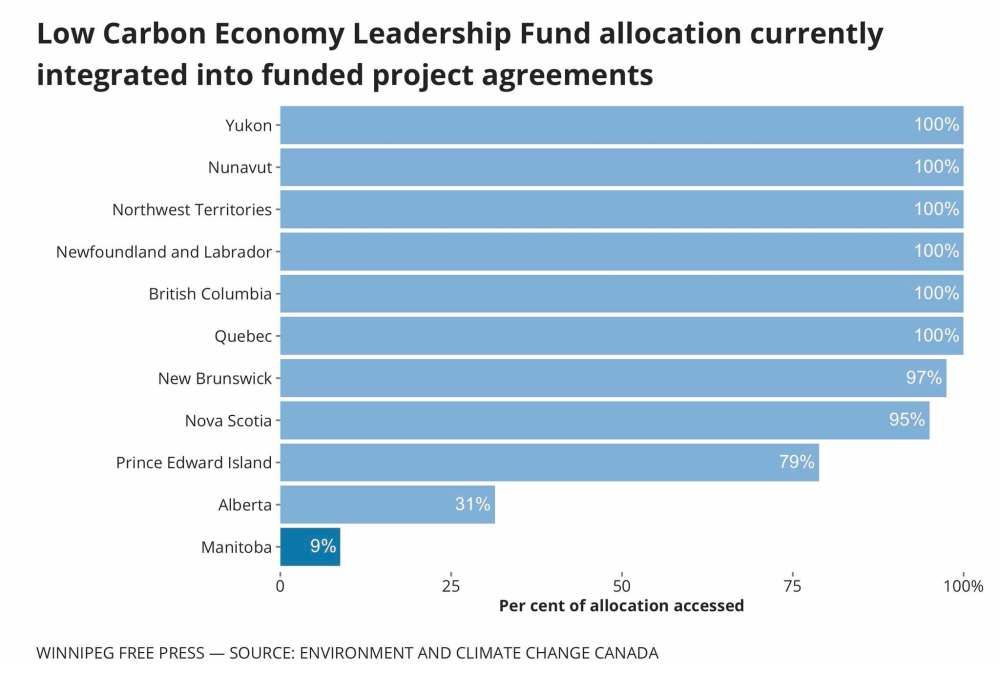Manitoba maintains glacial pace on accessing low-carbon project funds
Advertisement
Read this article for free:
or
Already have an account? Log in here »
To continue reading, please subscribe:
Monthly Digital Subscription
$0 for the first 4 weeks*
- Enjoy unlimited reading on winnipegfreepress.com
- Read the E-Edition, our digital replica newspaper
- Access News Break, our award-winning app
- Play interactive puzzles
*No charge for 4 weeks then price increases to the regular rate of $19.00 plus GST every four weeks. Offer available to new and qualified returning subscribers only. Cancel any time.
Monthly Digital Subscription
$4.75/week*
- Enjoy unlimited reading on winnipegfreepress.com
- Read the E-Edition, our digital replica newspaper
- Access News Break, our award-winning app
- Play interactive puzzles
*Billed as $19 plus GST every four weeks. Cancel any time.
To continue reading, please subscribe:
Add Free Press access to your Brandon Sun subscription for only an additional
$1 for the first 4 weeks*
*Your next subscription payment will increase by $1.00 and you will be charged $16.99 plus GST for four weeks. After four weeks, your payment will increase to $23.99 plus GST every four weeks.
Read unlimited articles for free today:
or
Already have an account? Log in here »
Hey there, time traveller!
This article was published 23/01/2021 (1783 days ago), so information in it may no longer be current.
The Manitoba government continues to dawdle on the prospect of capitalizing on federal funding available for low-carbon projects, lagging behind most other provinces.
Information obtained by the Free Press under freedom of information legislation showed, as of January, Manitoba has only accessed $5,862,999 of an available $66,754,000 from Ottawa’s low-carbon economy leadership fund.
The $5.9 million was allocated to a commercial trucking efficiency program, announced in June 2019.

The leadership fund consists of $1.4 billion divvied up between the provinces (part of the overall $2-billion Low Carbon Economy Fund). Projects are put forward by the respective provincial and territorial governments for federal approval and must, “generate clean growth, reduce greenhouse gas emissions, (and) help meet or exceed Canada’s Paris Agreement commitments,” in order to be greenlit.
Manitoba’s 8.8 per cent uptake compares with 100 per cent in B.C., Newfoundland and Labrador, Northwest Territories, Nunavut, Quebec, and Yukon.
When the Free Press previously reported on Manitoba’s failure to push low-carbon projects through the approval process a year ago, a memo obtained from the federal minister of environment and climate change’s office said three projects had been approved for funding in Manitoba, but only one had been announced.
Months later, no other projects had been unveiled by the province.
A spokesperson for Minister of Conservation and Climate Sarah Guillemard said the province “fully intends to invest the entire $67 million available through the Low Carbon Economy Fund — though projects planned through the fund will not be discussed publicly before they are announced.”
The statement also said approval of each project “requires intricate work and planning with our federal partners to gain approval.”
Projects approved in other parts of the country include retrofits, renewable energy projects, innovation spending, and the investments span across residential, commercial, industrial and post-secondary sectors.
This fall, Manitoba also took issue with the fund’s “strict criteria” for funding approval.
Federal Environment and Climate Change Minister Jonathan Wilkinson told the Free Press all approved projects would need to demonstrate how they would effectively reduce emissions. Going forward, he said not all funding would be deployed through the provinces.
“For example, there’s a billion-and-a-half dollars for communities to improve the energy efficiency of community buildings like hockey rinks, curling rinks and libraries. That will all certainly flow directly to municipalities. Some of the money will flow directly to individuals who want to improve the energy efficiency of their homes,” Wilkinson said.
Guillemard’s office said Manitobans can expect to hear about more approved projects “very soon.”
— with files from Dylan Robertson
sarah.lawrynuik@freepress.mb.ca

